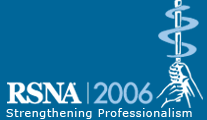
Abstract Archives of the RSNA, 2006
Bart Jeroen Emmer MD, Presenter: Nothing to Disclose
Egon van der Bijl, Abstract Co-Author: Nothing to Disclose
Ferry Breedveld MD, PhD, Abstract Co-Author: Nothing to Disclose
Tom WJ Huizinga, Abstract Co-Author: Nothing to Disclose
Mark A. Van Buchem MD, PhD, Abstract Co-Author: Nothing to Disclose
Jeroen van der Grond, Abstract Co-Author: Nothing to Disclose
Local inflammation plays a role in neurological conditions and processes like stroke/ischemia, trauma, epilepsy, multiple sclerosis, Alzheimer's and Parkinson's disease. However, the influence of systemic inflammation on the brain is less obvious. Systemic inflammation, characterized by increased circulating pro-inflammatory cytokines, has been implicated in cognitive decline and dementia. To study the influence of inflammation on the cerebral metabolism we used proton magnetic resonance spectroscopy (1H-MRS) in rheumatoid arthritis (RA) as a model of a chronic inflammatory condition.
35 RA patients (6 male; 29 female; age average: 51.8 years; standard deviation 14.6) with varying disease activity and varying treatment regimes and 28 healthy age and sex-matched control subjects were subjected to single voxel 1H-MRS using a double spin-echo PRESS sequence (TR/TE: 2000/136). None of the patients had any neurological signs or symptoms. Of the 35 RA patients, 22 used methotrexate. The volume-of-interest (VOI) was selected in the left centrum semi-ovale to ensure homogeneity of the selected tissue. N-acetylaspartate (NAA)/creatine and choline/creatine ratios were calculated for further analysis. In addition, laboratory values were associated with MRS findings.
RA patients did not show any significant difference in metabolite ratios compared to control subjects. However, active RA patients (i.e. elevated erythrocyte sedimentation rate (ESR)) had higher choline/creatine ratios (p<0.05) compared to inactive RA patients (normal ESR). Moreover, the choline/creatine ratio correlated significantly (r=0.45, p<0.05) with the ESR. No such associations were found for the NAA/creatine ratio. Patients who were under treatment with methotrexate demonstrated lower choline/creatine ratios (p<0.05) compared with patients not treated with methotrexate.
MR spectra in patients with active inflammation are characterized by an increased choline concentration, suggesting altered membrane related metabolism.
Future MRS studies should take the influence of systemic inflammation into account in their results.
Emmer, B,
van der Bijl, E,
Breedveld, F,
Huizinga, T,
Van Buchem, M,
van der Grond, J,
Evidence for Inflammatory Influence on the Brain: A Magnetic Resonance Spectroscopy Study.. Radiological Society of North America 2006 Scientific Assembly and Annual Meeting, November 26 - December 1, 2006 ,Chicago IL.
http://archive.rsna.org/2006/4431632.html

